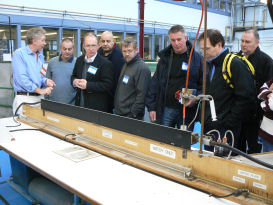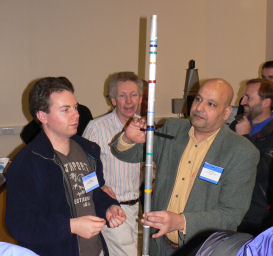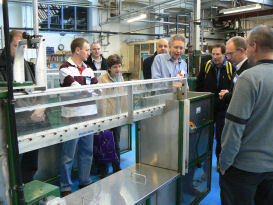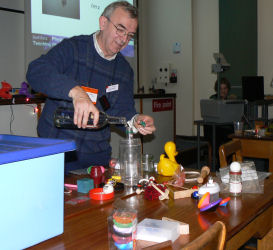The Institute of Physics (IOP) organises 'Physics Update' events devised to update physics teachers on innovations in physics, both pure and applied, and in curriculum matters.
"Hands-on" workshops afford teachers opportunities to try new equipment, develop new IT skills, learn new experimental techniques, try out novel investigations and engage with alternative teaching and learning strategies. The last update event was held here at the Department of Engineering hosted by Hugh Hunt. One teacher tells us more about the successful event:
Attending the Institute of Physics (IOP) Physics Update in the University of Cambridge Department of Engineering and Trinity College, Cambridge, December 8 to 10, 2006.
There's something delightful about becoming a physics student again for a weekend in the middle of a busy term of teaching. When you ring the IOP Teachers' Update team to enquire about available places Leila Solomon makes you feel so welcome that you want to encourage a couple of friends to go along as well. So this year veteran participant John Murphy, CBS, Dungarvan was joined by three new wide-eyed disciples : Noel Brett, Colaiste Chriost Ri, Cork, Paul Nugent, St. Dominic's High School, Sutton and Michael Grehan, Belvedere College, Dublin. Cambridge University was an inspiring venue for this Physics Update. By breakfast time we had walked in the footsteps of great Physicists and Engineers. In the Great Hall of Trinity College we dined under portraits of Sir Isaac Newton, James Clerk Maxwell and Ernest Rutherford. Most of our practicals took place in the Department of Engineering where Sir Frank Whittle pioneered Jet Propulsion.
We were warmly welcomed and shown around Trinity College by our local host, Dr. Hugh Hunt, who generously brought the event to Cambridge on this occasion. Hugh's enthusiasm matched his intimate knowledge of Trinity College as his guided tours continued long after dark and even wound up with a dizzying visit to the clock tower on the second evening! The particular qualities which enriched this IOP Physics Update were the enthusiasm and generosity of the 92 participants; qualities common to the distinguished presenters and the many teachers who freely shared their ideas and inventions with others. The event was also made possible by generous sponsorship from the Armourers and Brasiers' Company (1322), which has an ancient tradition of charitable giving, and from Canadian corporation Novelis.
Dr. Hugh Hunt is the man to ask about vibrations and harmonics, One of his many demos was simply a metal tube about 2 m long. Skilfully held at various different nodes, this produced a remarkable range of musical notes and of tonal quality. "We are all to some extent musical and in music we find beauty".
It's not every day you get treated to a lecture on the Great Laws of Physics by the Director of the Cavendish Laboratory – and that was a treat. Professor Malcolm Longair gave us fascinating insights into the creativity and ingenuity behind some big discoveries. Picture Faraday starting a revolution in 1831 by inventing field lines though he "knew no mathematics" - and again the intuitive way Maxwell used "analogies in nature" and wrote new mathematics to achieve the theoretical unification of light and electromagnetism. As Freeman Dyson has said: "Maxwell's theory had to wait for the next generation of physicists, Hertz and Lorenz and Einstein, to reveal its power and clarify its concepts."
On Saturday afternoon we had the honour of meeting the Master of Trinity College who has so many distinctions that I don't know how to give him his proper title. What strikes me most about Professor Sir Martin Rees is his relaxed, friendly personality and his skill in replying to questions. His lecture on dark matter opened up, for me, more of those surprises with which the Universe is so richly endowed. One of them tells us that in the Universe at age 10 -12 second all the particles had more energy than in CERN – and "We need much more physics to understand this". He reminded us that our Sun is a second or third generation star. So the heavier atoms in our bodies were made in supernova explosions and we have within us the ashes of dead stars. I went home with even more of a sense of wonder, reflecting on the astonishing events which got us here on this precious little planet.
What have the following got in common? A spinning top which keeps going for a whole workshop, another which levitates in mid-air, a third which inverts itself and continues to spin (courtesy of Euler's formula), a see-saw driven by a candle flame, a solid looking black disk which allows a pencil to pass though it freely, a Newton's cradle using magnets and a host of colourful optical illusions? They were among the physics toys we enjoyed playing with during the practical led by David Featonby who is IOP Teacher network coordinator for the North East. My students would have been enthralled too and described David as "ledge" – and a legend he is.
Space does not allow a proper sample of the delights of this IOP feast. They included the secrets of the electric guitar and Fourier Series ( Nick Weaver), the Physics of the Sun (Dr. Helen Mason), the real reason why an aircraft flies, shown in a real wind tunnel (Dr. Holger Babinsky), Materials of the future (Professor Lindsay Greer) and probably the most practical treasure of all : The Virtual Physical Laboratory – a wonderful suite of on-screen simulations created (presumably over thousands of hours of work) by Dr. John Nunn, supported by the National Physical Laboratory.
After lunch on Sunday we said our goodbyes to Leila Solomon, Hugh Hunt, David Featonby, John Nunn and other inspiring educators. The whole experience had been so uplifting that we hardly felt the need for Holger Babinsky's explanation of Bernoulli's principle as we raced down the runway at Stansted. The good news is that the IOP are at it again: Birmingham at the end of March and Cardiff in early July. I would warmly recommend any science teacher who is interested to apply for future IOP Physics Updates. They are as enjoyable as they are informative. Many many thanks to the organisers of the Cambridge event for an enriching experience of Physics Education at its best.
Michael Grehan, Belvedere College, Dublin.





